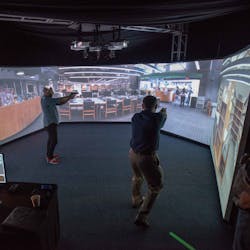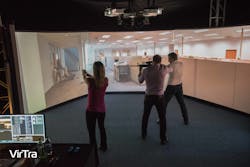De-Escalation: Core Law Enforcement Tool is Not Just a Fad
Media, community activists and today’s 24/7 “always on” news cycle have created tremendous public awareness of use of force incidents, and this environment has also increased attention on de-escalation. Yet what the media coverage often misses is the fact that de-escalation tactics have long been a staple of law enforcement training.
Another factor is that much of the public’s understanding of de-escalation in law enforcement revolves around the notion that it is something that is flipped on, like a light switch that can immediately stop a potentially dangerous situation. As everyone in law enforcement knows, this is absolutely not the case. De-escalation is not a device or a button, it is a process. The goal of de-escalation is to attempt to lessen the agitation or arousal of a subject being dealt with in hopes to get them to cooperate. Law enforcement cannot control the outcome; it can only influence the attempts, when they have the time and opportunity.
Major Kevin Shults, head of training for the Broward County Sheriff’s Office and a 32-year law enforcement veteran, agrees. “The public has a fundamental misunderstanding of what de-escalation is. Officers can only control 50 percent of a conversation in any situation, so from a training perspective, use of force instructors need to point out opportunities where officers can slow things down with appropriate de-escalation. But sometimes there are no good ways to de-escalate.” Another hard reality that the public often misses is that a substantial number of subjects that law enforcement must engage with in order to protect the public are often highly emotional, or are under a chemical or psychological influence that undermines rational behavior. “We don’t get called when people are having their best day,” says Shults. These mitigating factors add a layer of complexity to use of force engagements that makes de-escalation even more challenging for law enforcement.
The first documented de-escalation program that garnered widespread support in the law enforcement community was “Verbal Judo,” a book by Dr. George Thompson in 1993. De-escalation has changed since that time—it has evolved as we have learned more about human behavior, body chemistry and decision-making. Law enforcement constantly assimilates this new information and adapts strategies and techniques that allow use of force training and de-escalation tactics to become more efficient. In this ongoing evolution there is an increased emphasis on the training methods that incorporate these new learnings into policing—things like active listening and new technology.
Law enforcement adopt new strategies and techniques
The Salt Lake City Police Department emphasizes active listening de-escalation to help spot both verbal and non-verbal cues that indicate events may have preceded a current situation that can influence a subject’s behavior. Is a subject slurring their words or speaking in rapid, clipped sentences? Are there opportunities to acknowledge the subject’s feelings and convey empathy? Officers are coached to look for these subtle signals so they can build a positive rapport and steer a conversation in a direction that is more likely to result in a situation being diffused. This de-escalation involves a reciprocal interaction between two or more people and an understanding of how the emotions at play in the exchange can affect the decisions those people make.
Technology sometimes gets a bad rap for its inability to convey emotion—email and text message exchanges, for example. But the latest technology used by Salt Lake City and many other law enforcement agencies in their advanced use of force simulators incorporate a unique blend of both live-action using real actors, and simulated computer-generated scenarios that allow trainees to practice active listening and decoding emotions so they can learn to spot situations and opportunities to de-escalate without real-world consequences. Officers interact with suspects on multiple screens, and depending on how a trainee responds, a training supervisor operating the console can branch the scenario off into a number of different outcomes. If the officer skillfully uses active listening techniques, he can pick up on cues that lead a scenario down a path that does not require physical contact or drawing a firearm, and can result in a positive outcome for all parties involved. Embracing new technologies that can help law enforcement to prepare officers to respond appropriately can help change the way the public perceives de-escalation, and help the public better understand and appreciate the huge number of situations every day that end safely thanks to law enforcement using proper de-escalation techniques.
Continue the dialogue
Despite some of the erroneous perceptions around de-escalation and use of force, these discussions are an important part of the ongoing dialogue that we need to have to help change the public’s misunderstanding that de-escalation is not a button to be pushed or a net to be thrown. Using de-escalation tactics does not mean success, and at times it is not even a viable option. Law enforcement can “ask” a subject to comply, they can “tell” them to comply, but the only way to immediately stop someone engaged in behavior that threatens themselves, the officer or the public is to use immediate and overwhelming force to stop them.
As we continue to understand how human emotions affects decision-making, changes in drug use patterns, and underlying emotional disorders, there will be even more changes to de-escalation strategies. So despite all the current media attention, de-escalation is not a “craze”—it is a tool that law enforcement has always used, and it will continue to evolve as we develop more innovative technologies and marry them to a better understanding of human behavior.
About the Author
Bob Ferris | CEO
Ferris founded Ferris Productions, Inc. in 1993 and, after the merger between Ferris Productions and GameCom in September 2001, he became CEO of the combined company, VirTra, in 2008.





